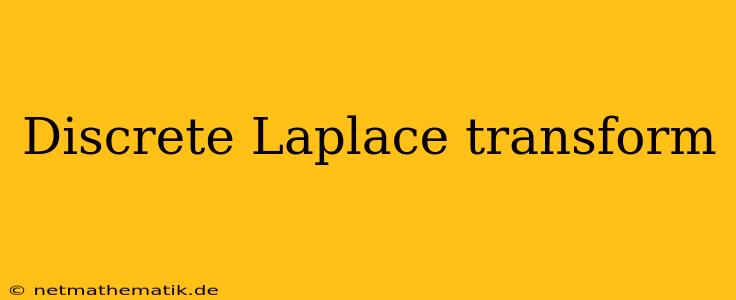The Discrete Laplace Transform (DLT) is a powerful tool in digital signal processing and discrete-time systems analysis. It offers a unique way to represent discrete-time signals in the complex frequency domain, allowing for efficient analysis and manipulation. This article delves into the core concepts of the Discrete Laplace Transform, exploring its definition, properties, and applications, providing a comprehensive understanding of this fundamental technique.
Understanding the Discrete Laplace Transform
The DLT is a generalization of the Z-transform, incorporating an exponential term that allows for the analysis of signals with complex frequencies. It transforms a discrete-time signal, represented as a sequence of values x[n], into a complex-valued function X(s), where 's' is a complex variable. This transformation facilitates various operations on the signal in the frequency domain, simplifying analysis and design.
Definition of the Discrete Laplace Transform
The DLT of a discrete-time signal x[n] is defined as follows:
$X(s) = \sum_{n=-\infty}^{\infty} x[n]e^{-sn}$
where:
- x[n] represents the discrete-time signal.
- s is a complex variable of the form s = σ + jω, where σ and ω are real numbers.
- e<sup>-sn</sup> is the exponential term, allowing for complex frequency analysis.
Properties of the Discrete Laplace Transform
The DLT exhibits several important properties that simplify signal analysis:
-
Linearity: The DLT is linear, meaning that the transform of a linear combination of signals is equal to the linear combination of their individual transforms: $DLT[a_1 x_1[n] + a_2 x_2[n]] = a_1 X_1(s) + a_2 X_2(s)$
-
Time Invariance: The DLT is time-invariant, meaning that a time shift in the input signal results in a multiplication by an exponential term in the output: $DLT[x[n-k]] = e^{-sk}X(s)$
-
Differentiation: The DLT of the first difference of a signal is equal to 's' multiplied by the transform of the original signal: $DLT[x[n] - x[n-1]] = (1-e^{-s})X(s)$
-
Convolution: The DLT of the convolution of two signals is equal to the product of their individual transforms: $DLT[x_1[n] * x_2[n]] = X_1(s)X_2(s)$
Region of Convergence (ROC)
The Region of Convergence (ROC) is a crucial aspect of the DLT, defining the range of complex values 's' for which the infinite sum in the DLT definition converges. The ROC plays a significant role in determining the uniqueness of the transform and the stability of the system.
The ROC is generally a region in the complex plane bounded by vertical lines. Its properties depend on the nature of the discrete-time signal x[n]:
- Finite-duration signals: The ROC is the entire complex plane.
- Right-sided signals: The ROC is a right half-plane, extending to the right of a vertical line.
- Left-sided signals: The ROC is a left half-plane, extending to the left of a vertical line.
- Two-sided signals: The ROC is a strip in the complex plane, bounded by two vertical lines.
Applications of the Discrete Laplace Transform
The DLT finds widespread applications in various fields, including:
1. System Analysis and Design
The DLT is invaluable for analyzing and designing linear time-invariant (LTI) systems in discrete time. By representing the system's impulse response in the frequency domain, the DLT simplifies the process of finding the system's output for a given input signal. This allows for efficient analysis of system properties like stability, frequency response, and transient behavior.
2. Signal Processing
The DLT is extensively used in digital signal processing, enabling operations like filtering, smoothing, and noise reduction. By transforming the signal into the frequency domain, specific frequencies can be selectively amplified or attenuated, leading to desired signal modifications.
3. Control Systems
The DLT finds applications in control systems for designing controllers that stabilize and optimize system behavior. By analyzing the system's transfer function in the frequency domain, controllers can be designed to meet performance requirements.
4. Image Processing
The DLT can be applied to image processing for tasks like edge detection and noise reduction. By representing the image in the frequency domain, specific spatial frequencies can be manipulated to achieve desired effects.
Advantages of the Discrete Laplace Transform
The DLT offers several advantages over other transforms, making it a preferred tool for various applications:
- Complex Frequency Analysis: The exponential term in the DLT allows for analyzing signals with complex frequencies, providing insights into both frequency and damping characteristics.
- Generalized Z-transform: The DLT is a generalization of the Z-transform, offering a wider range of analysis possibilities.
- Ease of Analysis: The DLT simplifies system analysis and design by allowing for manipulation of signals and systems in the frequency domain.
- Wide Range of Applications: The DLT is applicable to a wide range of fields, including signal processing, control systems, and image processing.
Conclusion
The Discrete Laplace Transform is a powerful mathematical tool that offers a unique perspective on the analysis and manipulation of discrete-time signals. Its ability to represent signals in the complex frequency domain, coupled with its useful properties, makes it a valuable technique for various applications. From system analysis and signal processing to control systems and image processing, the DLT plays a pivotal role in diverse engineering and scientific domains. Understanding the concept of the Discrete Laplace Transform provides a deeper understanding of discrete-time systems and opens doors to advanced signal processing techniques.
